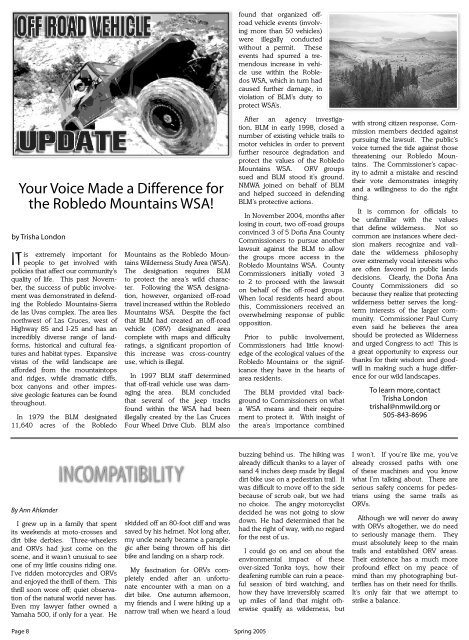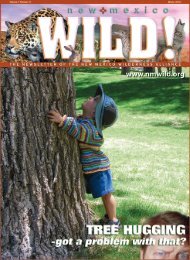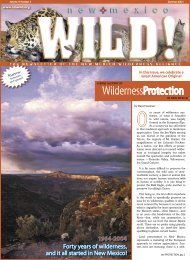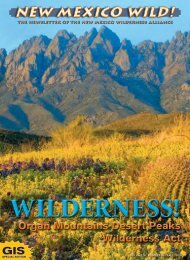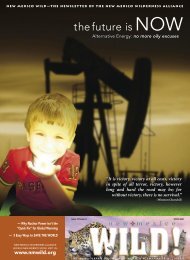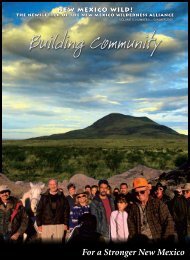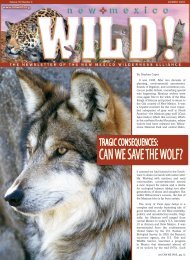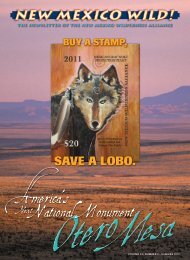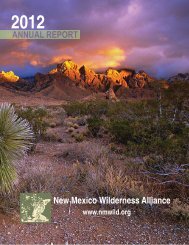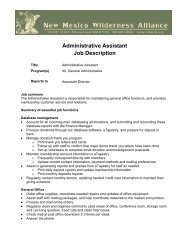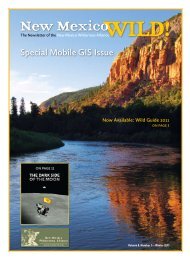FIGHTING THE GOOD FIGHT - New Mexico Wilderness Alliance
FIGHTING THE GOOD FIGHT - New Mexico Wilderness Alliance
FIGHTING THE GOOD FIGHT - New Mexico Wilderness Alliance
Create successful ePaper yourself
Turn your PDF publications into a flip-book with our unique Google optimized e-Paper software.
Your Voice Made a Difference for<br />
the Robledo Mountains WSA!<br />
by Trisha London<br />
is extremely important for<br />
IT people to get involved with<br />
policies that affect our community’s<br />
quality of life. This past November,<br />
the success of public involvement<br />
was demonstrated in defending<br />
the Robledo Mountains-Sierra<br />
de las Uvas complex. The area lies<br />
northwest of Las Cruces, west of<br />
Highway 85 and I-25 and has an<br />
incredibly diverse range of landforms,<br />
historical and cultural features<br />
and habitat types. Expansive<br />
vistas of the wild landscape are<br />
afforded from the mountaintops<br />
and ridges, while dramatic cliffs,<br />
box canyons and other impressive<br />
geologic features can be found<br />
throughout.<br />
In 1979 the BLM designated<br />
11,640 acres of the Robledo<br />
Mountains as the Robledo Mountains<br />
<strong>Wilderness</strong> Study Area (WSA).<br />
The designation requires BLM<br />
to protect the area’s wild character.<br />
Following the WSA designation,<br />
however, organized off-road<br />
travel increased within the Robledo<br />
Mountains WSA. Despite the fact<br />
that BLM had created an off-road<br />
vehicle (ORV) designated area<br />
complete with maps and diffi culty<br />
ratings, a signifi cant proportion of<br />
this increase was cross-country<br />
use, which is illegal.<br />
In 1997 BLM staff determined<br />
that off-trail vehicle use was damaging<br />
the area. BLM concluded<br />
that several of the jeep tracks<br />
found within the WSA had been<br />
illegally created by the Las Cruces<br />
Four Wheel Drive Club. BLM also<br />
found that organized offroad<br />
vehicle events (involving<br />
more than 50 vehicles)<br />
were illegally conducted<br />
without a permit. These<br />
events had spurred a tremendous<br />
increase in vehicle<br />
use within the Robledos<br />
WSA, which in turn had<br />
caused further damage, in<br />
violation of BLM’s duty to<br />
protect WSA’s.<br />
After an agency investigation,<br />
BLM in early 1998, closed a<br />
number of existing vehicle trails to<br />
motor vehicles in order to prevent<br />
further resource degradation and<br />
protect the values of the Robledo<br />
Mountains WSA. ORV groups<br />
sued and BLM stood it’s ground.<br />
NMWA joined on behalf of BLM<br />
and helped succeed in defending<br />
BLM’s protective actions.<br />
In November 2004, months after<br />
losing in court, two off-road groups<br />
convinced 3 of 5 Doña Ana County<br />
Commissioners to pursue another<br />
lawsuit against the BLM to allow<br />
the groups more access in the<br />
Robledo Mountains WSA. County<br />
Commissioners initially voted 3<br />
to 2 to proceed with the lawsuit<br />
on behalf of the off-road groups.<br />
When local residents heard about<br />
this, Commissioners received an<br />
overwhelming response of public<br />
opposition.<br />
Prior to public involvement,<br />
Commissioners had little knowledge<br />
of the ecological values of the<br />
Robledo Mountains or the significance<br />
they have in the hearts of<br />
area residents.<br />
The BLM provided vital background<br />
to Commissioners on what<br />
a WSA means and their requirement<br />
to protect it. With insight of<br />
the area’s importance combined<br />
with strong citizen response, Commission<br />
members decided against<br />
pursuing the lawsuit. The public’s<br />
voice turned the tide against those<br />
threatening our Robledo Mountains.<br />
The Commissioner’s capacity<br />
to admit a mistake and rescind<br />
their vote demonstrates integrity<br />
and a willingness to do the right<br />
thing.<br />
It is common for officials to<br />
be unfamiliar with the values<br />
that define wilderness. Not so<br />
common are instances where decision<br />
makers recognize and validate<br />
the wilderness philosophy<br />
over extremely vocal interests who<br />
are often favored in public lands<br />
decisions. Clearly, the Doña Ana<br />
County Commissioners did so<br />
because they realize that protecting<br />
wilderness better serves the longterm<br />
interests of the larger community.<br />
Commissioner Paul Curry<br />
even said he believes the area<br />
should be protected as <strong>Wilderness</strong><br />
and urged Congress to act! This is<br />
a great opportunity to express our<br />
thanks for their wisdom and goodwill<br />
in making such a huge difference<br />
for our wild landscapes.<br />
To learn more, contact<br />
Trisha London<br />
trishal@nmwild.org or<br />
505-843-8696<br />
By Ann Ahlander<br />
INCOMPATIBILITY<br />
I grew up in a family that spent<br />
its weekends at moto-crosses and<br />
dirt bike derbies. Three-wheelers<br />
and ORVs had just come on the<br />
scene, and it wasn’t unusual to see<br />
one of my little cousins riding one.<br />
I’ve ridden motorcycles and ORVs<br />
and enjoyed the thrill of them. This<br />
thrill soon wore off; quiet observation<br />
of the natural world never has.<br />
Even my lawyer father owned a<br />
Yamaha 500, if only for a year. He<br />
skidded off an 80-foot cliff and was<br />
saved by his helmet. Not long after,<br />
my uncle nearly became a paraplegic<br />
after being thrown off his dirt<br />
bike and landing on a sharp rock.<br />
My fascination for ORVs completely<br />
ended after an unfortunate<br />
encounter with a man on a<br />
dirt bike. One autumn afternoon,<br />
my friends and I were hiking up a<br />
narrow trail when we heard a loud<br />
buzzing behind us. The hiking was<br />
already diffi cult thanks to a layer of<br />
sand 4 inches deep made by illegal<br />
dirt bike use on a pedestrian trail. It<br />
was diffi cult to move off to the side<br />
because of scrub oak, but we had<br />
no choice. The angry motorcyclist<br />
decided he was not going to slow<br />
down. He had determined that he<br />
had the right of way, with no regard<br />
for the rest of us.<br />
I could go on and on about the<br />
environmental impact of these<br />
over-sized Tonka toys, how their<br />
deafening rumble can ruin a peaceful<br />
session of bird watching, and<br />
how they have irreversibly scarred<br />
up miles of land that might otherwise<br />
qualify as wilderness, but<br />
I won’t. If you’re like me, you’ve<br />
already crossed paths with one<br />
of these machines and you know<br />
what I’m talking about. There are<br />
serious safety concerns for pedestrians<br />
using the same trails as<br />
ORVs.<br />
Although we will never do away<br />
with ORVs altogether, we do need<br />
to seriously manage them. They<br />
must absolutely keep to the main<br />
trails and established ORV areas.<br />
Their existence has a much more<br />
profound effect on my peace of<br />
mind than my photographing butterfl<br />
ies has on their need for thrills.<br />
It’s only fair that we attempt to<br />
strike a balance.<br />
Page 8 Spring 2005


